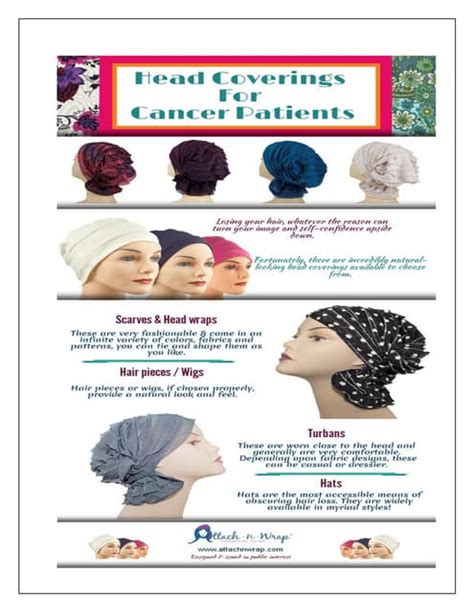Introduction

Cancer treatments, such as chemotherapy and radiation therapy, often lead to hair loss. This can be a devastating side effect, affecting both physical appearance and emotional well-being. Head coverings offer a practical and stylish solution, providing both comfort and confidence during this challenging time.
Benefits of Head Coverings
- Protection: Head coverings shield the scalp from sun exposure, wind, and cold.
- Comfort: Soft, breathable fabrics reduce scalp irritation and provide a comfortable fit.
- Privacy: Head coverings offer a sense of privacy and control over their appearance.
- Confidence: A well-chosen head covering can boost self-esteem and empower patients to embrace their journey.
Types of Head Coverings
The wide range of head coverings available caters to different styles, preferences, and medical needs.
- Scarves: Versatile and easy to wear, scarves come in various fabrics and patterns.
- Hats: From beanies to baseball caps, hats offer warmth, coverage, and a casual look.
- Wigs: Wigs provide a natural look and can mimic the patient’s original hair.
- Turbans: Turbans are stylish and comfortable, concealing scalp hair loss while adding a touch of elegance.
- Headbands: Headbands offer partial coverage and can be worn under hats or scarves for added security.
Choosing the Right Coverings
Selecting the right head covering is a personal decision. Consider the following factors:
- Style: Choose coverings that complement your personal style and taste.
- Medical needs: Some coverings may be more appropriate for certain treatments or scalp sensitivities.
- Comfort: Opt for materials that feel soft and breathable against the skin.
- Budget: Head coverings range in price, so determine a comfortable budget before shopping.
Tips for Wearing Head Coverings
- Experiment with different styles: Find the coverings that best suit your face shape and head size.
- Accessorize: Add scarves, pins, or bows to create unique looks.
- Care for your coverings: Follow care instructions to maintain the appearance and lifespan of your coverings.
Choosing Wigs
Wigs offer a natural hair replacement option. When selecting a wig, consider:
- Material: Human hair wigs provide a natural look but require more maintenance. Synthetic wigs are durable and affordable.
- Fit: The wig should fit snugly around the head without causing discomfort.
- Style: Choose a wig that complements your facial features and hair texture.
Accessories for Head Coverings
- Hats and scarves: Wear hats over scarves for additional coverage and warmth.
- Headbands: Use headbands to keep coverings in place or add a touch of style.
- Bandanas: Bandanas offer a casual and versatile option for covering the scalp.
- Pins and clips: Secure scarves and head coverings with decorative pins or clips.
Community Support
Cancer support organizations and online forums provide a supportive community for cancer patients wearing head coverings. These groups offer:
- Advice and tips: Share experiences and learn from others’ journeys.
- Emotional support: Connect with others who understand the challenges of hair loss.
- Resources: Access information on head coverings and other supportive services.
Conclusion
Head coverings empower cancer patients to embrace their journey with comfort, confidence, and style. By understanding their options, choosing the right coverings, and accessing community support, patients can navigate hair loss as an integral part of their treatment. Remember, you are not alone, and there is no right or wrong way to cover your head. Embrace the opportunity to express your individuality and find solace in the support of others.
